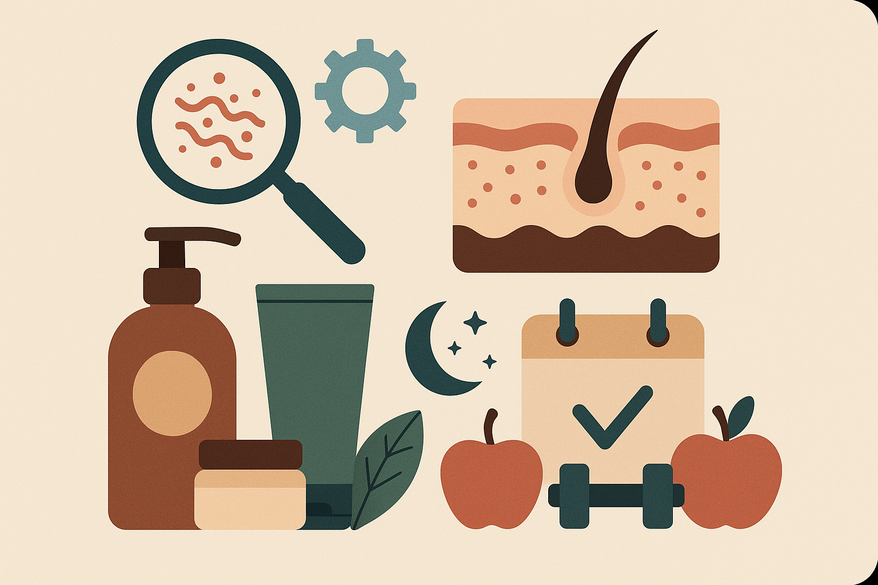10 Expert Tips to Prevent Recurring Rashes and Maintain Healthy Skin
Discover 10 expert tips to prevent recurring rashes and maintain healthy skin through identifying triggers, daily routines, and lifestyle changes.

Estimated reading time: 10 minutes
Key Takeaways
- Gentle skin care and regular moisturizing restore the skin barrier.
- Identify and avoid triggers through testing and a reaction diary.
- Manage stress and eat a balanced diet to boost skin health.
- Wear protective clothing, use gloves, and apply sunscreen daily.
- Seek medical advice for rashes that are severe, long-lasting, or unresponsive to home care.
Table of Contents
- What Are Recurring Rashes?
- Common Causes and Triggers
- Skin-Care & Lifestyle Strategies
- When to See a Healthcare Professional
- Home Remedies & Natural Treatments
- FAQ
What Are Recurring Rashes?
Recurring rashes can disrupt daily life; understanding their nature is the first step toward prevention.
Definition
- Rashes that return repeatedly after periods of improvement.
Common Symptoms
- Redness, swelling, itching, burning, flakiness
- May worsen at night or with friction
Chronic Types
- Eczema (Atopic Dermatitis): Dry, itchy patches requiring hydration and barrier repair.
- Contact Dermatitis: Reaction to direct contact with irritants or allergens.
- Chronic Hives (Urticaria): Raised welts lasting over six weeks.
Why Understanding Matters
Tailoring prevention—whether through trigger avoidance, hydration, or immunotherapy—starts with knowing your rash type.
Common Causes and Triggers
Allergens vs. Irritants
- Allergens: Pollen, pet dander, certain foods like peanuts or shellfish.
- Irritants: Harsh soaps, detergents, alcohol-based sanitizers, fragranced cosmetics.
Environmental Factors
Heat and humidity increase sweat, which can break down the skin barrier and trap bacteria—learn simple daily habits to stay cool and dry. Low humidity, on the other hand, dries skin and creates entry points for irritants.
Lifestyle Habits
- Over-scrubbing or using rough loofahs damages the outer skin layer.
- Tight clothing traps sweat and increases friction.
Mechanism of Recurrence
Repeated trigger exposure impairs the protective barrier, allowing moisture loss and irritant entry—setting off another rash.
Skin-Care & Lifestyle Strategies
Gentle Skin-Care Routine
- Cleanse Gently
Use mild, fragrance-free, pH-balanced cleansers with lukewarm water only; avoid hot showers and scrubbing. - Moisturize Regularly
Choose hypoallergenic, non-comedogenic ceramide-rich, fragrance-free moisturizers. Apply within three minutes of patting dry to lock in moisture. - Patch-Test New Products
Dab a small amount on your inner forearm for 48 hours and watch for redness or swelling before full-body use.
Identifying & Avoiding Allergens
- Allergy Testing
Patch tests for contact allergens; blood tests (IgE) for food or environmental triggers. - Practical Tips
Keep a reaction diary of foods, products, and environments when rashes flare. Switch to fragrance-free detergents and skincare.
Lifestyle Modifications
- Stress Management
High cortisol from chronic stress weakens skin immunity. Try meditation apps, deep-breathing, or gentle yoga. - Nutrition
Eat whole grains and colorful fruits/vegetables for antioxidants. Omega-3s (salmon, flaxseed) reduce inflammation. Drink at least eight cups of water daily. - Sleep Hygiene
Aim for 7–9 hours per night and maintain a regular schedule to support skin regeneration.
Protective Measures
- Clothing
Opt for loose, breathable fabrics like cotton or moisture-wicking blends. - Gloves
Wear when handling cleaning agents or chemicals at home or work. - Sun Protection
Apply broad-spectrum sunscreen SPF 30+ daily; wear hats and long sleeves on sunny days.
For ongoing monitoring, consider using Rash Detector, an AI skin analysis app offering instant insights into your rash patterns and triggers.

When to See a Healthcare Professional
Warning Signs
- Rash lasting more than two weeks.
- Severe pain, oozing, bleeding, or crusting lesions.
- Accompanied by fever, chills, or rapid spread.
- Unresponsive to over-the-counter treatments.
Medical Evaluations
Patch testing or blood work to pinpoint allergens; skin biopsy to rule out infection or autoimmune conditions.
Prescription Options
- Topical corticosteroids and calcineurin inhibitors for inflammation.
- Oral antihistamines for itch relief.
- Phototherapy for severe, chronic cases.
Home Remedies & Natural Treatments
- Oatmeal Baths
Prepare a colloidal oatmeal bath: grind oats into a fine powder, sprinkle under warm running water. Benefits: soothes inflammation, reinforces the skin barrier (complete guide). - Cool Compresses
Use a damp, clean cloth cooled in the fridge. Apply for 10 minutes to reduce itching and redness. - Plant-Based Lotions
Aloe Vera gel (pure, fragrance-free) for soothing; virgin coconut oil (50% MCTs) to nourish. Always patch-test.
Pros: Low cost, minimal side effects for mild relief.
Cons: Limited efficacy on root causes; seek professional care if severe or persistent.
FAQ
- What triggers recurring rashes?
Common triggers include allergens (pollen, foods), irritants (soaps, fragrances), environmental factors (heat, low humidity), and lifestyle habits like over-scrubbing or tight clothing. - How often should I moisturize?
Apply a ceramide-rich moisturizer within three minutes after bathing and reapply as needed, especially if you notice dryness or flakiness. - When should I see a dermatologist?
If your rash lasts over two weeks, is severe, oozing, or unresponsive to home care, seek professional evaluation. - Can diet affect my skin?
A balanced diet rich in antioxidants and omega-3 fatty acids can reduce inflammation and support skin health. - Are home remedies effective?
They offer mild relief and barrier support but may not address underlying causes—consult a professional for persistent or severe cases.





